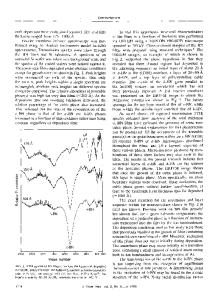Phase Evolution of Turbostratic Boron Nitride During the Deposition of Cubic Boron Nitride Film
- PDF / 268,235 Bytes
- 4 Pages / 612 x 792 pts (letter) Page_size
- 67 Downloads / 397 Views
In-Hoon Choi Department of Materials Science, Korea University, Anam5-ga, 136-720, Seoul, Korea
Young-Joon Baik Thin Film Technology Research Center, Korea Institute of Science and Technology, P.O. Box 131, Cheongyang, 130-650, Seoul, Korea (Received April 27, 2001; accepted February 28, 2002)
The formation of turbostratic boron nitride (tBN) phase on the cubic boron nitride (cBN) phase was investigated at specific conditions. The cBN film was deposited on the Si substrate by unbalanced magnetron sputtering. When the bias voltage at the substrate was adjusted to –85 V, the tBN phase nucleated on the cBN phase and grew simultaneously with the cBN phase. This was a critical bias voltage below which only the tBN phase was formed. The surface morphology of this film was typically shown as nodules dispersed on a very flat surface. The formation of nodulelike tBN phases seemed to be caused by a small variation of local stress on the growth surface. Once the nucleation of the nodulelike tBN phase occurred, the growth of tBN phase was accelerated. Transmission electron microscopy result showed evidence of the stress relaxation of the film caused by the formation of tBN phase at the interface of the tBN and cBN phases. The synthesis of cubic boron nitride (cBN) from the gas phase has been an attractive issue for a decade due to the ambiguity of its synthesis mechanism1– 4; thermodynamic states under the deposition conditions can hardly be described precisely to justify its stability during the deposition, since the cBN is a thermodynamically stable phase at high pressure. It is generally known that the cBN formation is followed by a sequential deposition of amorphous and turbostratic layers.5 Once the cBN phase nucleates on the turbostratic BN (tBN) layer, it continues to grow even at the lower ion energy where the cBN phase cannot nucleate.6,7 In this study, we present the deposition behavior of the cBN phase on a critical boundary of ion energy, below which only the tBN phase was formed. The nodulelike tBN phase was found to form and grow even after the whole surface of the film was covered by the cBN phase. Then both the tBN and cBN phases grew simultaneously. A detailed analysis of the microstructural characteristics of this film was performed using transmission electron microscopy (TEM).
a)
e-mail: [email protected]
944
http://journals.cambridge.org
J. Mater. Res., Vol. 17, No. 5, May 2002 Downloaded: 12 Apr 2015
We deposited films on the Si substrate at 400 °C using an unbalanced magnetron sputtering method with a hexagonal boron nitride (hBN) target. After both the target and the substrate with an Ar–10% N2 mixed-gases plasma were presputtered at 1.35 mtorr for 5 min, the BN films were deposited at 450 W of the target radiofrequency electric power and with various direct current substrate bias voltages. The film was analyzed using Fourier-transform infrared spectroscopy (FTIR; Galaxy 5030 FTIR, Thermo Mattson, WI) and TEM at 200 kV (Philips CM30, Eindhoven, The Netherlands) and at 300 keV (Hitachi K9000 NAR,
Data Loading...











